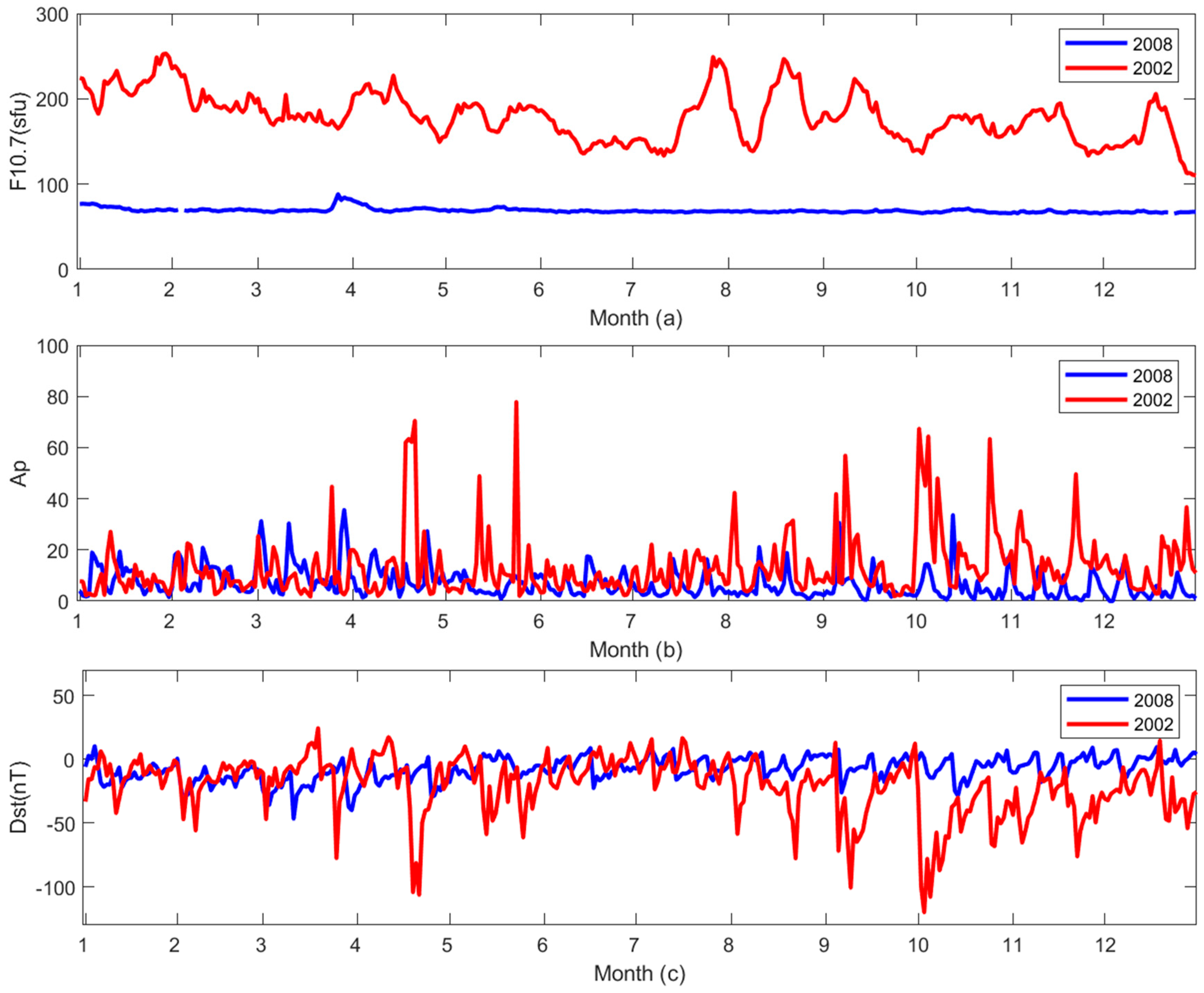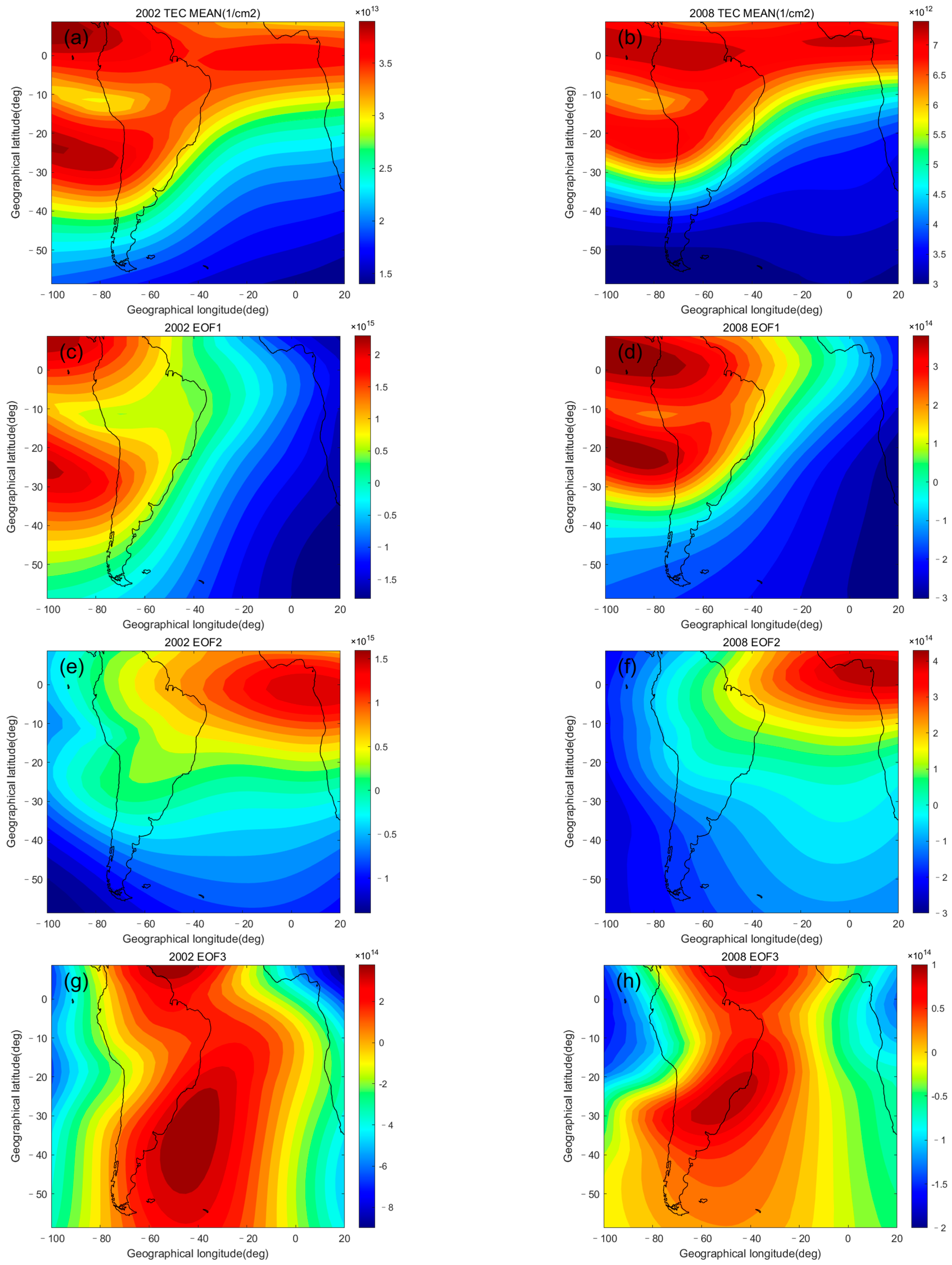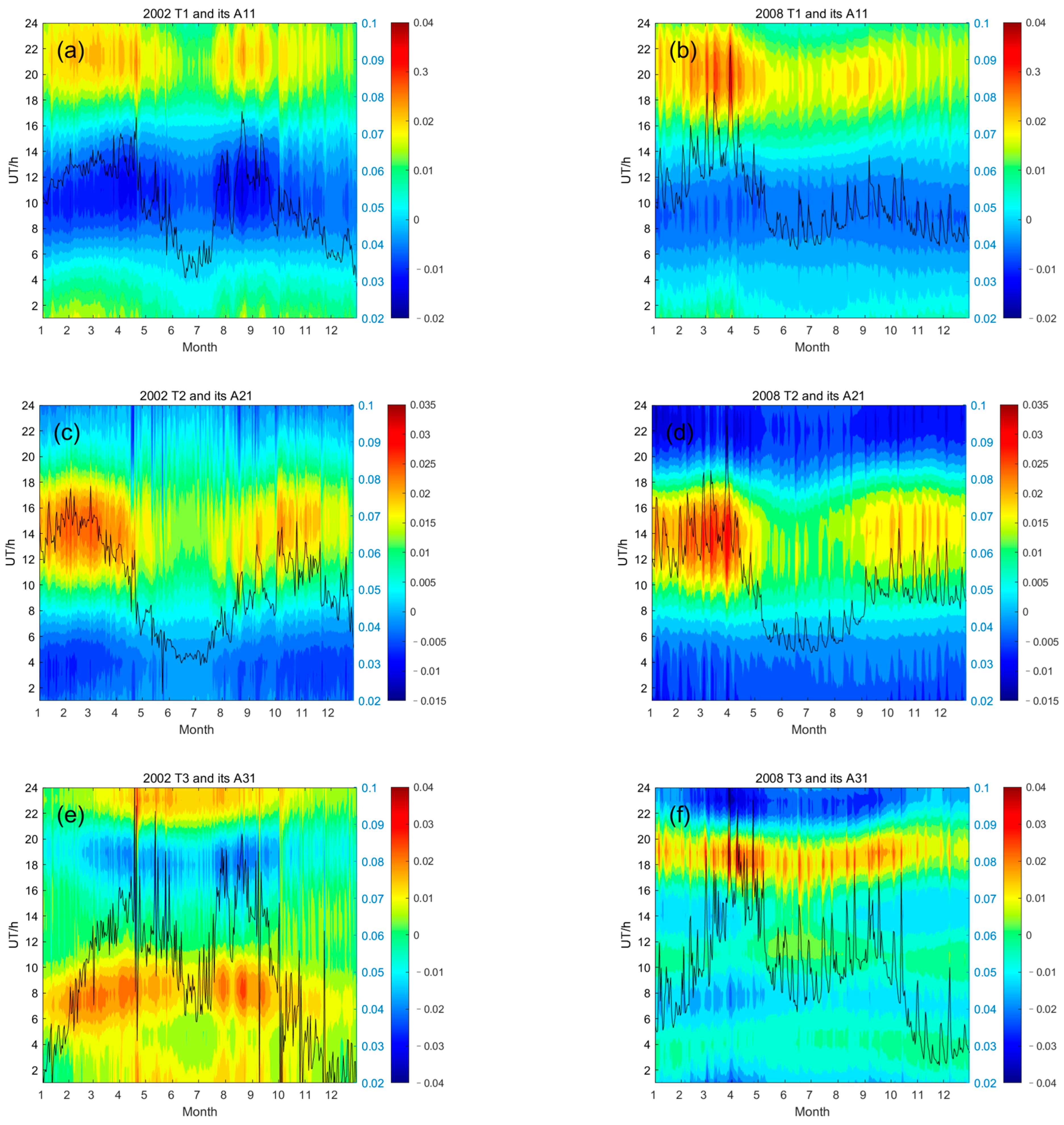An Empirical Orthogonal Function Study of the Ionospheric TEC Predicted Using the TIEGCM Model over the South Atlantic Anomaly in 2002 and 2008
Abstract
1. Introduction
2. Model and Method
2.1. TIEGCM Model
2.2. EOF Analysis Method
3. Results
4. Interpretation and Discussion
4.1. TEC Mean Field
4.2. First Mode
4.3. Second Mode
4.4. Third Mode
5. Summary
- (1)
- Similarities: Although the change in the intensity of the solar activity had a strong influence on the magnitude of TEC, it did not change the spatial and temporal characteristics of the TEC much. Whether it was in the solar maximum or solar minimum, spatially, EOF1 and EOF3 reflected the EIA influenced by plasma drift; in addition, EOF1 also reflected the east–west asymmetry, which may have been related to the variation in the magnetic declination angle, and the zonal wind; EOF2 mainly reflected the zonal variation in the TEC, which was highly correlated with the solar EUV radiation. Temporally, T1 to T3 mainly reflected the semiannual variation in the TEC, which could not be simply explained by the variation in the [O/N2], but the variation in the solar zenith angle and atmospheric circulation also provided significant contributions; T3 reflected the winter anomaly influenced by the [O/N2]. It also indicates that these distribution features were regular features of the TEC distribution over the SAA.
- (2)
- Differences: The values and amplitude variation in the TEC, which were strongly modulated by the solar activity, were significantly greater in the solar maximum than that in the solar minimum. Under the influence of the solar EUV radiation intensity, the active range of the zonal variation and the EIA in the SAA also expanded with the increase in the solar activity intensity. The spring–autumn asymmetry was observed in the ionospheric TEC during the solar minimum. Furthermore, it can be seen from the correlation that the TEC was mainly influenced by the solar radiation (F10.7) in the solar maximum (r = 0.7348), while the TEC was mainly influenced by the geomagnetic activity (Dst) in the solar minimum (r = −0.7898).
Author Contributions
Funding
Data Availability Statement
Conflicts of Interest
References
- Forbes, J.M.; Palo, S.E.; Zhang, X. Ionospheric variability. J. Atmos. Sol. Terr. Phys. 2000, 62, 685–694. [Google Scholar] [CrossRef]
- Rishbeth, H.; Mendillo, M. Patterns of F2-layer variability. J. Atmos. Sol.-Terr. Phys. 2001, 63, 1661–1680. [Google Scholar] [CrossRef]
- Echer, E.; Gonzalez, W.D.; Guarnieri, F.L.; Dal Lago, A.; Vieira, L.E.A. Introduction to space weather. Adv. Space Res. 2005, 35, 855–865. [Google Scholar] [CrossRef]
- Nelson, G.J. Total ionospheric electron content at middle latitudes during sunspot minimum. J. Atmos. Terr. Phys. 1968, 30, 513–526. [Google Scholar] [CrossRef]
- Jakowski, N.; Mayer, C.; Hoque, M.M.; Wilken, V. Total electron content models and their use in ionosphere monitoring. Radio Sci. 2011, 46, 1–11. [Google Scholar] [CrossRef]
- Mendillo, M. Storms in the ionosphere: Patterns and processes for total electron content. Rev. Geophys. 2006, 44, 4. [Google Scholar] [CrossRef]
- Yu, T.; Wan, W.; Liu, L.; Zhao, B. Global scale annual and semi-annual variations of daytime NmF2 in the high solar activity years. J. Atmos. Sol.-Terr. Phys. 2004, 66, 1691–1701. [Google Scholar] [CrossRef]
- Zhao, B.; Wan, W.; Liu, L.; Mao, T.; Ren, Z.; Wang, M.; Christensen, A.B. Features of annual and semiannual variations derived from the global ionospheric maps of total electron content. Ann. Geophys. 2007, 25, 2513–2527. [Google Scholar] [CrossRef]
- Ercha, A.; Zhang, D.; Ridley, A.J.; Xiao, Z.; Hao, Y. A global model: Empirical orthogonal function analysis of total electron content 1999–2009 data. J. Geophys. Res. Space Phys. 2012, 117, A3. [Google Scholar]
- Guo, J.; Li, W.; Liu, X.; Kong, Q.; Zhao, C.; Guo, B. Temporal-spatial variation of global GPS-derived total electron content, 1999–2013. PLoS ONE 2015, 10, e0133378. [Google Scholar] [CrossRef]
- Immel, T.J.; Sagawa, E.; England, S.L.; Henderson, S.B.; Hagan, M.E.; Mende, S.B.; Paxton, L.J. Control of equatorial ionospheric morphology by atmospheric tides. Geophys. Res. Lett. 2006, 33, 15. [Google Scholar] [CrossRef]
- Horvath, I.; Lovell, B.C. Investigating the relationships among the South Atlantic Magnetic Anomaly, southern nighttime midlatitude trough, and nighttime Weddell Sea Anomaly during southern summer. J. Geophys. Res. Space Phys. 2009, 114, A2. [Google Scholar] [CrossRef]
- Horvath, I.; Essex, E.A. The Weddell Sea Anomaly observed with the TOPEX satellite data. J. Atmos. Sol.-Terr. Phys. 2003, 65, 693–706. [Google Scholar] [CrossRef]
- Lean, J.L.; Meier, R.R.; Picone, J.M.; Sassi, F.; Emmert, J.T.; Richards, P.G. Ionospheric total electron content: Spatial patterns of variability. J. Geophys. Res. Space Phys. 2016, 121, 10–367. [Google Scholar] [CrossRef]
- Mao, T.; Wan, W.; Yue, X.; Sun, L.; Zhao, B.; Guo, J. An empirical orthogonal function model of total electron content over China. Radio Sci. 2008, 43, 1–12. [Google Scholar] [CrossRef]
- Chen, Z.; Zhang, S.R.; Coster, A.J.; Fang, G. EOF analysis and modeling of GPS TEC climatology over North America. J. Geophys. Res. Space Phys. 2015, 120, 3118–3129. [Google Scholar] [CrossRef]
- Jamjareegulgarn, P.; Ansari, K.; Ameer, A. Empirical orthogonal function modelling of total electron content over Nepal and comparison with global ionospheric models. Acta Astronaut. 2020, 177, 497–507. [Google Scholar] [CrossRef]
- Heirtzler, J.R. The future of the South Atlantic anomaly and implications for radiation damage in space. J. Atmos. Sol.-Terr. Phys. 2002, 64, 1701–1708. [Google Scholar] [CrossRef]
- Pavon-Carrasco, F.J.; De Santis, A. The South Atlantic anomaly: The key for a possible geomagnetic reversal. Front. Earth Sci. 2016, 4, 40. [Google Scholar] [CrossRef]
- Casolino, M.; Bidoli, V.; Morselli, A.; Narici, L.; De Pascale, M.P.; Picozza, P.; Fuglesang, C. Dual origins of light flashes seen in space. Nature 2003, 422, 680. [Google Scholar] [CrossRef] [PubMed]
- Eastes, R.W.; McClintock, W.E.; Burns, A.G.; Anderson, D.N.; Andersson, L.; Aryal, S. Initial observations by the GOLD mission. J. Geophys. Res. Space Phys. 2020, 125, e2020JA027823. [Google Scholar] [CrossRef]
- Cai, X.; Qian, L.; Wang, W.; McInerney, J.M.; Liu, H.-L.; Eastes, R.W. Hemispherically asymmetric evolution of nighttime ionospheric equatorial ionization anomaly in the American longitude sector. J. Geophys. Res. Space Phys. 2022, 127, e2022JA030706. [Google Scholar] [CrossRef]
- Zeng, Z.; Burns, A.; Wang, W.; Lei, J.; Solomon, S.; Syndergaard, S.; Qian, L.; Kuo, Y.H. Ionospheric annual asymmetry observed by the COSMIC radio occultation measurements and simulated by the TIEGCM. J. Geophys. Res. Space Phys. 2008, 113, A7. [Google Scholar] [CrossRef]
- Rao, S.S.; Chakraborty, M.; Kumar, S.; Singh, A.K. Low-latitude ionospheric response from GPS, IRI and TIE-GCM TEC to Solar Cycle 24. Astrophys. Space Sci. 2019, 364, 216. [Google Scholar] [CrossRef]
- Roble, R.G.; Ridley, E.C.; Richmond, A.D.; Dickinson, R.E. A coupled thermosphere/ionosphere general circulation model. Geophys. Res. Lett. 1988, 15, 1325–1328. [Google Scholar] [CrossRef]
- Richmond, A.D.; Ridley, E.C.; Roble, R.G. A thermosphere/ionosphere general circulation model with coupled electrodynamics. Geophys. Res. Lett. 1992, 19, 601–604. [Google Scholar] [CrossRef]
- Qian, L.; Burns, A.G.; Emery, B.A.; Foster, B.; Lu, G.; Maute, A.; Wang, W. The NCAR TIE-GCM: A community model of the coupled thermosphere/ionosphere system. Model. Ionos.-Syst. 2014, 73–83. [Google Scholar]
- Li, Z.; Sun, M.; Li, J.; Zhang, K.; Zhang, H.; Xu, X.; Zhao, X. Significant Variations of Thermospheric Nitric Oxide Cooling during the Minor Geomagnetic Storm on 6 May 2015. Universe 2022, 8, 236. [Google Scholar] [CrossRef]
- Heelis, R.A.; Lowell, J.K.; Spiro, R.W. A model of the high-latitude ionospheric convection pattern. J. Geophys. Res. Space Phys. 1982, 87, 6339–6345. [Google Scholar] [CrossRef]
- Maute, A. Thermosphere-ionosphere-electrodynamics general circulation model for the ionospheric connection explorer: TIEGCM-ICON. Space Sci. Rev. 2017, 212, 523–551. [Google Scholar] [CrossRef]
- Kopp, G. Magnitudes and timescales of total solar irradiance variability. J. Space Weather. Space Clim. 2016, 6, A30. [Google Scholar] [CrossRef]
- Hagan, M.E.; Forbes, J.M. Migrating and nonmigrating diurnal tides in the middle and upper atmosphere excited by tropospheric latent heat release. J. Geophys. Res. Atmos. 2002, 107, ACL-6. [Google Scholar] [CrossRef]
- Pearson, K. LIII. On lines and planes of closest fit to system of points in space. Lond. Edinb. Dublin Philos. Mag. J. Sci. 1901, 2, 559–572. [Google Scholar] [CrossRef]
- Björnsson, H.; Venegas, S.A. A manual for EOF and SVD analyses of climatic data. CCGCR Rep. 1997, 97, 112–134. [Google Scholar]
- Jolliffe, I.T. Principal Component Analysis, 2nd ed.; Springer: New York, NY, USA, 2002. [Google Scholar]
- Wilks, D.S. Principal component (EOF) analysis. In International Geophysics; Academic Press: Cambridge, MA, USA, 2011; Volume 100, pp. 519–562. [Google Scholar]
- Li, Z.; Knipp, D.; Wang, W.; Shi, Y.; Wang, M.; Su, Y.; Li, J. An EOFs study of thermospheric nitric Oxide flux based on TIEGCM simulations. J. Geophys. Res. Space Phys. 2019, 124, 9695–9708. [Google Scholar] [CrossRef]
- Flynn, S.; Knipp, D.J.; Matsuo, T.; Mlynczak, M.; Hunt, L. Understanding the global variability in thermospheric nitric oxide flux using empirical orthogonal functions (EOFs). J. Geophys. Res. Space Phys. 2018, 123, 4150–4170. [Google Scholar] [CrossRef]
- Kaufmann, P.; Piazza, L.R.; Massambani, O.; Borges, V.D.; Koppe, E.H. Longitudinal dependence of ionospheric total electron content in the South Atlantic Geomagnetic Anomaly. Nature 1976, 261, 677–679. [Google Scholar] [CrossRef]
- Massambani, O. The east-west asymmetry of the ionospheric electron content in south Atlantic geomagnetic anomaly region. J. Atmos. Terr. Phys. 1978, 40, 1143–1146. [Google Scholar] [CrossRef]
- Sojka, J.J.; David, M.; Schunk, R.W.; Heelis, R.A. A modeling study of the longitudinal dependence of storm time midlatitude dayside total electron content enhancements. J. Geophys. Res. 2012, 117, A02315. [Google Scholar] [CrossRef]
- Zhang, S.R.; Foster, J.C.; Holt, J.M.; Erickson, P.J.; Coster, A.J. Magnetic declination and zonal wind effects on longitudinal differences of ionospheric electron density at midlatitudes. J. Geophys. Res. Space Phys. 2012, 117, A8. [Google Scholar] [CrossRef]
- Liu, L.; Chen, Y. Statistical analysis of solar activity variations of total electron content derived at Jet Propulsion Laboratory from GPS observations. J. Geophys. Res. 2009, 114, A10311. [Google Scholar] [CrossRef]
- Zhao, H.; Yang, L.; Xu, S. Analysis of Ionospheric TEC Variation Characteristics in Solar Activity Years. J. Navig. Position. 2017, 5, 24–30. [Google Scholar]
- Scherliess, L.; Thompson, D.C.; Schunk, R.W. Longitudinal variability of low-latitude total electron content: Tidal influences. J. Geophys. Res. Space Phys. 2008, 113, A1. [Google Scholar] [CrossRef]
- Wu, C.C.; Fry, C.D.; Liu, J.Y.; Liou, K.; Tseng, C.L. Annual TEC variation in the equatorial anomaly region during the solar minimum: September 1996–August 1997. J. Atmos. Sol.-Terr. Phys. 2004, 66, 199–207. [Google Scholar] [CrossRef]
- Wu, C.C.; Liou, K.; Shan, S.J.; Tseng, C.L. Variation of ionospheric total electron content in Taiwan region of the equatorial anomaly from 1994 to 2003. Adv. Space Res. 2008, 41, 611–616. [Google Scholar] [CrossRef]
- Ma, R.; Jiyao, X.; Huaizhe, L. The features and a possible mechanism of semiannual variation in the peak electron density of the low latitude F2 layer. J. Atmos. Sol.-Terr. Phys. 2003, 65, 47–57. [Google Scholar] [CrossRef]
- Chen, Y.; Liu, L.; Wan, W.; Ren, Z. Equinoctial asymmetry in solar activity variations of NmF2 and TEC. Ann. Geophys. 2012, 30, 613–622. [Google Scholar] [CrossRef]
- Liu, R.-Y.; Wu, Y.-W.; Zhang, B.C. Comparisons of the variation of the ionospheric TEC with NmF2 over China. In Proceedings of the XXXIth URSI General Assembly and Scientific Symposium (URSI GASS), Beijing, China, 16–23 August 2014; pp. 1–4. [Google Scholar]
- Millward, G.H.; Rishbeth, H.; Fuller-Rowell, T.J.; Aylward, A.D.; Quegan, S.; Moffett, R.J. Ionospheric F 2 layer seasonal and semiannual variations. J. Geophys. Res. Space Phys. 1996, 101, 5149–5156. [Google Scholar] [CrossRef]
- Rishbeth, H.; Müller-Wodarg, I.C.F.; Zou, L.; Fuller-Rowell, T.J.; Millward, G.H.; Moffett, R.J.; Aylward, A.D. Annual and semiannual variations in the ionospheric F2-layer: II. Physical discussion. Ann. Geophys. 2000, 18, 945–956. [Google Scholar] [CrossRef]
- Liu, L.; Wan, W.; Ning, B.; Zhang, M.L. Climatology of the mean total electron content derived from GPS global ionospheric maps. J. Geophys. Res. Space Phys. 2009, 114, A6. [Google Scholar] [CrossRef]
- Rishbeth, H. How the thermospheric circulation affects the ionospheric F2-layer. J. Atmos. Sol.-Terr. Phys. 1998, 60, 1385–1402. [Google Scholar] [CrossRef]



| EOF Type | 2002 (%) | 2008 (%) |
|---|---|---|
| EOF1 × T1 | 65.59% | 59.85% |
| EOF2 × T2 | 25.23% | 29.98% |
| EOF3 × T3 | 3.98% | 4.03% |
| EOF Type | 2002 (%) | 2008 (%) |
|---|---|---|
| T1: E11 × A11 | 98.84% | 98.13% |
| T2: E21 × A21 | 97.00% | 98.57% |
| T3: E31 × A31 | 91.21% | 89.23% |
| Dst | F10.7 | Ap | ||
|---|---|---|---|---|
| 2002 | T1: A11 | −0.1401 | 0.7348 | 0.2116 |
| T2: A21 | −0.1884 | 0.5109 | 0.0658 | |
| T3: A31 | 0.148 | 0.2987 | 0.083 | |
| 2008 | T1: A11 | −0.7898 | 0.0336 | 0.6407 |
| T2: A21 | −0.6706 | 0.0718 | 0.5307 | |
| T3: A31 | −0.5247 | −0.0238 | 0.6021 | |
Disclaimer/Publisher’s Note: The statements, opinions and data contained in all publications are solely those of the individual author(s) and contributor(s) and not of MDPI and/or the editor(s). MDPI and/or the editor(s) disclaim responsibility for any injury to people or property resulting from any ideas, methods, instructions or products referred to in the content. |
© 2023 by the authors. Licensee MDPI, Basel, Switzerland. This article is an open access article distributed under the terms and conditions of the Creative Commons Attribution (CC BY) license (https://creativecommons.org/licenses/by/4.0/).
Share and Cite
Yu, J.; Li, Z.; Wang, Y.; Shao, J.; Wang, L.; Li, J.; Zhang, H.; Xu, X.; Gu, C. An Empirical Orthogonal Function Study of the Ionospheric TEC Predicted Using the TIEGCM Model over the South Atlantic Anomaly in 2002 and 2008. Universe 2023, 9, 102. https://doi.org/10.3390/universe9020102
Yu J, Li Z, Wang Y, Shao J, Wang L, Li J, Zhang H, Xu X, Gu C. An Empirical Orthogonal Function Study of the Ionospheric TEC Predicted Using the TIEGCM Model over the South Atlantic Anomaly in 2002 and 2008. Universe. 2023; 9(2):102. https://doi.org/10.3390/universe9020102
Chicago/Turabian StyleYu, Jing, Zheng Li, Yan Wang, Jingjing Shao, Luyao Wang, Jingyuan Li, Hua Zhang, Xiaojun Xu, and Chunli Gu. 2023. "An Empirical Orthogonal Function Study of the Ionospheric TEC Predicted Using the TIEGCM Model over the South Atlantic Anomaly in 2002 and 2008" Universe 9, no. 2: 102. https://doi.org/10.3390/universe9020102
APA StyleYu, J., Li, Z., Wang, Y., Shao, J., Wang, L., Li, J., Zhang, H., Xu, X., & Gu, C. (2023). An Empirical Orthogonal Function Study of the Ionospheric TEC Predicted Using the TIEGCM Model over the South Atlantic Anomaly in 2002 and 2008. Universe, 9(2), 102. https://doi.org/10.3390/universe9020102







